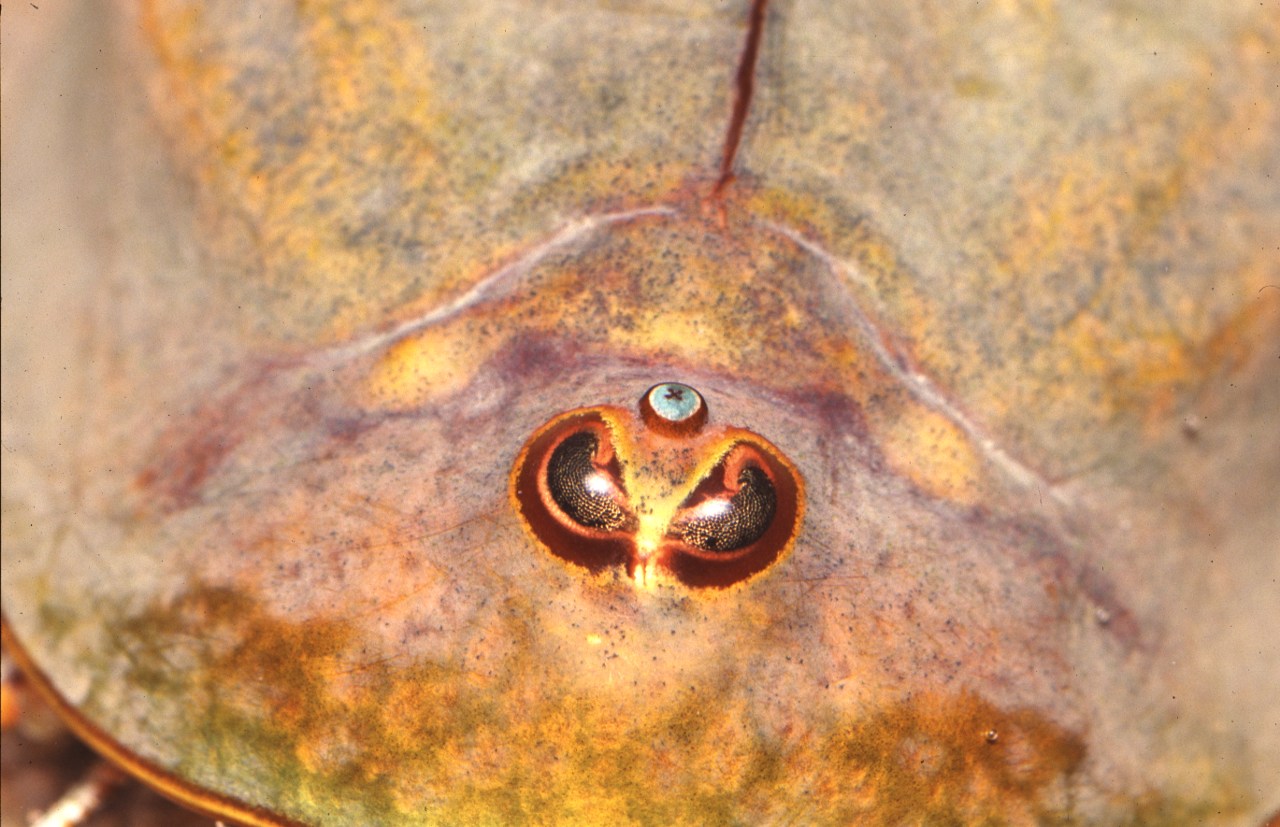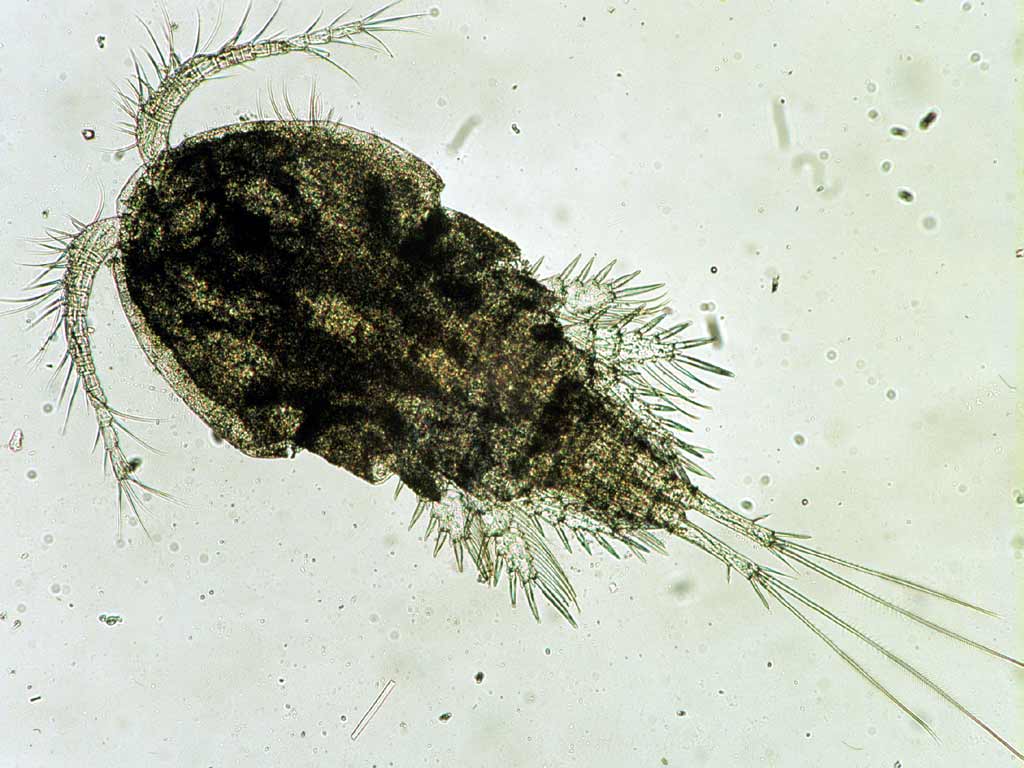|
Notostraca
The order Notostraca, containing the single family Triopsidae, is a group of crustaceans known as tadpole shrimp or shield shrimp. The two genera, ''Triops'' and ''Lepidurus'', are considered living fossils, with similar forms having existed since the end of the Devonian, around 360 million years ago. They have a broad, flat carapace, which conceals the head and bears a single pair of compound eyes. The abdomen is long, appears to be segmented and bears numerous pairs of flattened legs. The telson is flanked by a pair of long, thin caudal rami. Phenotypic plasticity within taxa makes species-level identification difficult, and is further compounded by variation in the mode of reproduction. Notostracans are omnivores living on the bottom of temporary pools and shallow lakes. Description Notostracans are long, with a broad carapace at the front end, and a long, slender abdomen. This gives them a similar overall shape to a tadpole, from which the common name ''tadpole shrimp'' derive ... [...More Info...] [...Related Items...] OR: [Wikipedia] [Google] [Baidu] |
Triops Australiensis Belly
''Triops'', from Ancient Greek τρία (''tría''), meaning "three", and ὄψ (''óps''), meaning "face" or "eye", is a genus of small crustaceans in the order Notostraca (tadpole shrimp). The long-lasting resting eggs of several species of ''Triops'' are commonly sold in kits as pets. The animals hatch upon contact with fresh water. Most adult-stage ''Triops'' have a life expectancy of up to 90 days and can tolerate a pH range of 6 to 10. In nature, they often inhabit temporary pools. Relatives and fossil record The genus ''Triops'' can be distinguished from the only other living genus of Notostraca, ''Lepidurus'', by the form of the telson (the end of its 'tail'), which bears only a pair of long, thin caudal extensions in ''Triops'', while ''Lepidurus'' also bears a central platelike process. Only 24 hours after hatching they already resemble miniature versions of the adult form. ''Triops'' are sometimes called "living fossils", since fossils that have been attributed to ... [...More Info...] [...Related Items...] OR: [Wikipedia] [Google] [Baidu] |
Lepidurus Apus
''Lepidurus apus'', commonly known as a tadpole shrimp, is a notostracan in the family Triopsidae, one of a lineage of shrimp-like crustaceans that have had a similar form since the Triassic period and are considered living fossils. This species is Cosmopolitan distribution, cosmopolitan, inhabiting temporary freshwater ponds over much of the world, and the most widespread of the tadpole shrimps. Like other notostracans, ''L. apus'' has a broad carapace, long segmented abdomen, and large numbers of paddle-like legs. It reproduces by a mixture of sexual reproduction and self-fertilisation of females. Description ''Lepidurus apus'' grows to in length. Its long abdomen is divided into about 30 segment-like rings, with two long caudal rami or "tails" attached behind the last ring. Between the tails is a projection which distinguishes ''Lepidurus'' from ''Triops'', the other notostracan genus. Its carapace is flat with an average length of , and is attached only at the front, coverin ... [...More Info...] [...Related Items...] OR: [Wikipedia] [Google] [Baidu] |
Lepidurus
''Lepidurus'' is a genus of small crustaceans in the order Notostraca (tadpole shrimp). It is the larger of the two extant genera of the tadpole shrimps, the other being ''Triops''. They are commonly found in vernal pools and survive dry periods with the help of long lasting resting eggs. The genus contains the following species: *''Lepidurus apus'' (Carl Linnaeus, Linnaeus, 10th edition of Systema Naturae, 1758) *''Lepidurus arcticus'' (Peter Simon Pallas, Pallas, 1793) *''Lepidurus batesoni'' Longhurst, 1955 *''Lepidurus bilobatus'' Alpheus Spring Packard, Packard, 1883 *''Lepidurus couesii'' Alpheus Spring Packard, Packard, 1875 *''Lepidurus cryptus'' D. C. Rogers, 2001 *''Lepidurus lemmoni'' Samuel Jackson Holmes, Holmes, 1894 *''Lepidurus mongolicus'' Vekhoff, 1992 *''Lepidurus packardi'' Simon, 1886 References External links * Notostraca Branchiopoda genera Taxa named by William Elford Leach Taxonomy articles created by Polbot {{Branchiopoda-stub ... [...More Info...] [...Related Items...] OR: [Wikipedia] [Google] [Baidu] |
Triops Australiensis
''Triops australiensis'', sometimes referred to as a shield shrimp, is an Australian species of the tadpole shrimp ''Triops''. Distribution ''Triops australiensis'' has a wide distribution across Australia, excluding the northernmost parts of Western Australia, and Queensland. It is also absent from Tasmania in the south, where it is replaced by ''Lepidurus apus''. The two species can be distinguished by the presence of a supra-anal plate between the caudal rami at the end of the abdomen in ''L. apus'', which is lacking in ''T. australiensis''. Biology ''T. australiensis'' inhabits temporary pools of water in the arid regions of the Australian outback. When desiccated pools fill with water, the resting eggs hatch into nauplii, and rapidly develop to adulthood. Reproduction succeeds within a few weeks of hatching. Adults achieve a maximum size of around , which is considered large for a tadpole shrimp. Water chemistry ''Triops australiensis'' can tolerate a pH of 7–9, a ... [...More Info...] [...Related Items...] OR: [Wikipedia] [Google] [Baidu] |
Crustacean
Crustaceans (from Latin meaning: "those with shells" or "crusted ones") are invertebrate animals that constitute one group of arthropods that are traditionally a part of the subphylum Crustacea (), a large, diverse group of mainly aquatic arthropods including decapods (shrimps, prawns, crabs, lobsters and crayfish), seed shrimp, branchiopods, fish lice, krill, remipedes, isopods, barnacles, copepods, opossum shrimps, amphipods and mantis shrimp. The crustacean group can be treated as a subphylum under the clade Mandibulata. It is now well accepted that the hexapods (insects and entognathans) emerged deep in the Crustacean group, with the completed pan-group referred to as Pancrustacea. The three classes Cephalocarida, Branchiopoda and Remipedia are more closely related to the hexapods than they are to any of the other crustaceans ( oligostracans and multicrustaceans). The 67,000 described species range in size from '' Stygotantulus stocki'' at , to the Japanese ... [...More Info...] [...Related Items...] OR: [Wikipedia] [Google] [Baidu] |
Temporary Pool
Vernal pools, also called vernal ponds or ephemeral pools, are seasonal pools of water that provide habitat for distinctive plants and animals. They are considered to be a distinctive type of wetland usually devoid of fish, and thus allow the safe development of natal amphibian and insect species unable to withstand competition or predation by fish. Certain tropical fish lineages (such as killifishes) have however adapted to this habitat specifically. Vernal pools are a type of wetland. They can be surrounded by many communities/species including deciduous forest, grassland, lodgepole pine forest, blue oak woodland, sagebrush steppe, succulent coastal scrub and prairie. These pools are characteristic of Mediterranean climates, but occur in many other ecosystems. Generation and annual development During most years, a vernal pool basin will experience inundation from rain/precipitation, followed by desiccation from evapotranspiration. These conditions are commonly associated with ... [...More Info...] [...Related Items...] OR: [Wikipedia] [Google] [Baidu] |
Segmentation (biology)
Segmentation in biology is the division of some animal and plant body plans into a linear series of repetitive segments that may or may not be interconnected to each other. This article focuses on the segmentation of animal body plans, specifically using the examples of the taxa Arthropoda, Chordata, and Annelida. These three groups form segments by using a "growth zone" to direct and define the segments. While all three have a generally segmented body plan and use a growth zone, they use different mechanisms for generating this patterning. Even within these groups, different organisms have different mechanisms for segmenting the body. Segmentation of the body plan is important for allowing free movement and development of certain body parts. It also allows for regeneration in specific individuals. Definition Segmentation is a difficult process to satisfactorily define. Many taxa (for example the molluscs) have some form of serial repetition in their units but are not conventi ... [...More Info...] [...Related Items...] OR: [Wikipedia] [Google] [Baidu] |
Arthropod Leg
The arthropod leg is a form of jointed appendage of arthropods, usually used for walking. Many of the terms used for arthropod leg segments (called podomeres) are of Latin origin, and may be confused with terms for bones: ''coxa'' (meaning hip (anatomy), hip, : ''coxae''), ''trochanter'', ''femur'' (: ''femora''), ''tibia'' (: ''tibiae''), ''tarsus'' (: ''tarsi''), ''ischium'' (: ''ischia''), ''metatarsus'', ''carpus'', ''dactylus'' (meaning finger), ''patella'' (: ''patellae''). Homology (biology), Homologies of leg segments between groups are difficult to prove and are the source of much argument. Some authors posit up to eleven segments per leg for the most recent common ancestor of Neontology, extant arthropods but modern arthropods have eight or fewer. It has been argued that the ancestral leg need not have been so complex, and that other events, such as successive loss of function of a Homeobox, ''Hox''-gene, could result in Parallel evolution, parallel gains of leg segments ... [...More Info...] [...Related Items...] OR: [Wikipedia] [Google] [Baidu] |
John Wiley And Sons
John Wiley & Sons, Inc., commonly known as Wiley (), is an American multinational publishing company that focuses on academic publishing and instructional materials. The company was founded in 1807 and produces books, journals, and encyclopedias, in print and electronically, as well as online products and services, training materials, and educational materials for undergraduate, graduate, and continuing education students. History The company was established in 1807 when Charles Wiley opened a print shop in Manhattan. The company was the publisher of 19th century American literary figures like James Fenimore Cooper, Washington Irving, Herman Melville, and Edgar Allan Poe, as well as of legal, religious, and other non-fiction titles. The firm took its current name in 1865. Wiley later shifted its focus to scientific, technical, and engineering subject areas, abandoning its literary interests. Wiley's son John (born in Flatbush, New York, October 4, 1808; died in East ... [...More Info...] [...Related Items...] OR: [Wikipedia] [Google] [Baidu] |
Cambridge University Press
Cambridge University Press was the university press of the University of Cambridge. Granted a letters patent by King Henry VIII in 1534, it was the oldest university press in the world. Cambridge University Press merged with Cambridge Assessment to form Cambridge University Press and Assessment under Queen Elizabeth II's approval in August 2021. With a global sales presence, publishing hubs, and offices in more than 40 countries, it published over 50,000 titles by authors from over 100 countries. Its publications include more than 420 academic journals, monographs, reference works, school and university textbooks, and English language teaching and learning publications. It also published Bibles, runs a bookshop in Cambridge, sells through Amazon, and has a conference venues business in Cambridge at the Pitt Building and the Sir Geoffrey Cass Sports and Social Centre. It also served as the King's Printer. Cambridge University Press, as part of the University of Cambridge, was a ... [...More Info...] [...Related Items...] OR: [Wikipedia] [Google] [Baidu] |
Caudal Ramus
The caudal ramus (plural: ''caudal rami'') is a characteristic feature of primitive crustaceans. Located on the anal somite (telson segment), the caudal ramus is a pair of appendage An appendage (or outgrowth) is an external body part or natural prolongation that protrudes from an organism's body such as an arm or a leg. Protrusions from single-celled bacteria and archaea are known as cell-surface appendages or surface app ...-like or spine-like protrusions. Specific structures which are rod or blade-like are referred to as '' caudal furca''. References *Brusca, Gary J. & Richard C. Brusca, ''Invertebrates''. 2003. Crustacean anatomy {{crustacean-stub ... [...More Info...] [...Related Items...] OR: [Wikipedia] [Google] [Baidu] |








